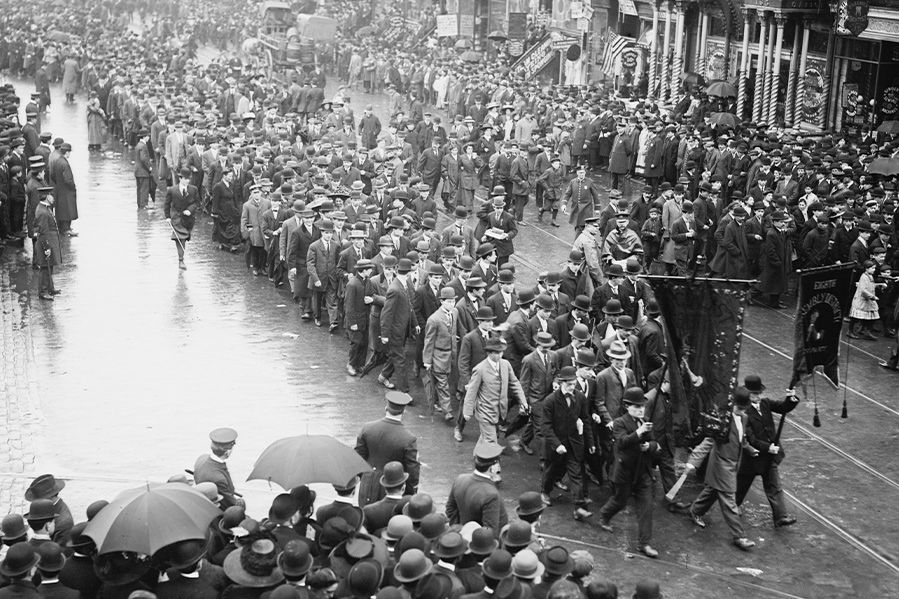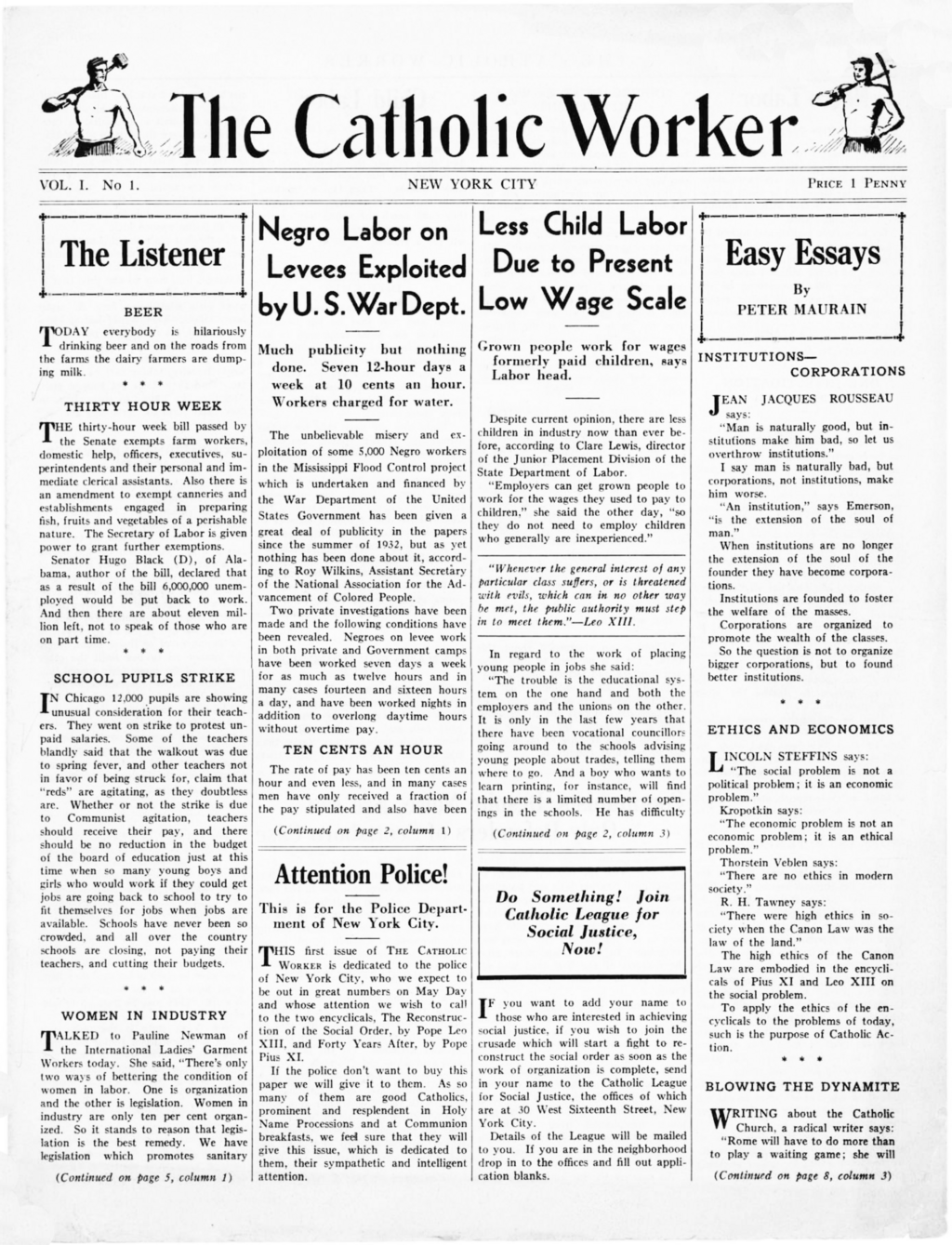
On September 1st, millions of Americans will celebrate Labor Day, the federal holiday that gifts American workers a well-earned three-day weekend of rest and relaxation. Picnics, parades, and backyard barbecues mark this unofficial end of summer, which became a national holiday in 1894.
But did you know: while Labor Day is mostly a secular affair today, it has some fascinating faith origins.
Here's the secret religious history of Labor Day.
How Did Labor Day Begin?
By the mid-1800s, America’s workforce was being ground down by the gears of the Industrial Revolution. Agricultural life gave way to factories where men, women, and even children labored 12 hours a day, 7 days a week, for paltry wages. Kids as young as five worked shifts in unsafe conditions. On-the-job deaths and injuries in factories, foundries, and mills were common.
Unions rose in righteous protest. Through strikes and rallies, they eventually secured hard-fought victories: the 8-hour day, the 5-day week, child labor laws, minimum wages, and safety regulations that we now take for granted.
As part of this movement came a holiday to celebrate workers and workers' rights. On September 5, 1882, some 10,000 workers – nearly all union men – marched through New York City in a raucous celebration of the labor movement’s growth and achievements.
They marched again the following year, and within a decade, thirty states had adopted the holiday. President Cleveland finally declared it a federal holiday in 1894.
Religious Themes of Labor Day
Religious themes were woven throughout the labor movement. Organizers often referenced scripture to back their arguments for better working conditions. Among the most-cited passages were:
- '"Woe to him who builds his house by unrighteousness, and his upper rooms by injustice, who makes his neighbor serve him for nothing and does not give him his wages” (Jeremiah 22:13).
- “Behold, the wages of the laborers who mowed your fields, which you kept back by fraud, are crying out against you, and the cries of the harvesters have reached the ears of the Lord of hosts” (James 5:4).
The very first Labor Day celebration was actually the joint effort of two major labor organizations: the Central Labor Union and the Knights of Labor.
The Knights were led by Terence V. Powderly, a devout Catholic so serious he refused both drink and smoke. Powderly argued in 1893 that Labor Day – and the labor movement itself – were rooted in Christian faith. He wrote:
“Trades-unionists, members of guilds, leagues and other organizations of workingmen embraced Christianity and proclaimed its doctrines as being especially advantageous to the welfare of the toiling poor … If Labor Day is observed as it ought to be, the gospel of humanity will be understood by all men and women.”
Powderly pointed directly to Jesus’ commands – “Love thy neighbor as thyself” and “Do unto others as you would have them do unto you” – as the moral backbone of the holiday.
But it was the support of a much larger faith organization that typified religion's role in the movement.
Rerum Novarum: How the Vatican Backed Labor
As worker unrest stirred around the world, Pope Leo XIII decided to weigh in on the issue. In 1891, he issued the encyclical Rerum Novarum, a pro-labor document that marked a turning point in how the Catholic Church engaged with the working class.
Rerum Novarum directly addressed the struggles of the industrial era, affirmed laborers’ rights to form unions, called for just wages sufficient to support a family, and framed workplace dignity as a moral imperative grounded in Christian teaching. While it criticized both unfettered capitalism and radical socialism, the document represented a seismic shift in the Church's view of labor and its support for "the working man".
Importantly, it also provided clergy with a theological foundation to support workers’ rights without being viewed as political activists.
What Role Did Clergy Play in the Labor Movement?
Catholics frequently spoke up in support of labor causes. Among the highest profile supporters was Cardinal James Gibbons of Baltimore, who famously used Rerum Novarum to defend the Knights of Labor.
But clergy members from across denominations joined the fight, too.
Congregational pastor Washington Gladden emerged as one of the earliest and most vocal supporters of organized labor. A leading figure in the Social Gospel movement, Gladden argued that fair wages and safe conditions were not simply economic issues but Christian imperatives. Through sermons, essays, and public lectures, he called on churches to see the dignity of work as central to living out the gospel.
Episcopal leaders joined the cause as well. In 1887, Bishop Henry C. Potter helped establish the Church Association for the Advancement of the Interests of Labor (CAIL), whose pro-labor members preached from pulpits, wrote op-eds, and organized forums that linked Christian teaching to economic justice.

The Catholic Worker: Faith and Labor Unite
Several generations later, Catholic activists Dorothy Day and Peter Maurin founded The Catholic Worker in 1933, a newspaper that supported labor movements through the lens of Catholic teachings.
From this popular chronicle spawned a faith-based social movement to support the working class, as well as those on the fringes of society.
In addition to charitable works in the community, Catholic Workers often showed up at protests and picket lines to support laborers.
The movement later grew into a nationwide (and then worldwide) network of chapters providing hospitality to the working class and the poor. Today, over 200 chapters are active around the world.
Day, who served as the periodical's editor until her death in 1980, once wrote “What we do is very little, but it’s like the little boy with a few loaves and fishes. Christ took that little and increased it. He will do the rest.”
She is under consideration for sainthood by the Catholic Church.
Rest for the Worker, Rest for the Soul
Today, few Americans see Labor Day as anything more than the last long weekend of summer. But that is largely thanks to previous generations of workers, activists, and faith leaders who fought for better working conditions.
While it may not technically be a religious holiday, Labor Day's origins are inextricably tied to religious beliefs about dignity – in one's life, and one's labor.
9 comments
-
I always try to support labor unions. Ergophobia & job dedication are both important. Respect, between labor, Mgmt.,& work quality are very important. Love not hate or maudlin.I , sometimes go on Retreaton Labor Day,for: Child Enforcement Support &.the courts & my Uncle Sammy,even bit, my butt !
-
Who is labor day about?
-
That was a really interesting read, kudos to it's author.
Unfortunately unions have gone corrupt and no longer look it for the workers in most cases. Workers just pay the dues with nothing in return, not really. There are clicks in unions that favor certain trades within.
As with all things started in righteousness, it succumbs to corruption once Man get in the door.
Still, fantastic read, happy labor day!!
-
Sodomy is also a commandment when I was younger! It need to be re-establish in the commandments it's very dangerous an causes health issues! Food for thought!
-
I'm glad they finally did a eight hour day of work with five days a week. Equaling 40 hours a week. But with breaks that are not paid you lose in fast food 2 1/2 hours a week. That gives you 37.5 hours per paycheck! An with 12.00 a hour being a single parent there is no way to even live an pay bills. You have to live on welfare just to make it an sometimes that doesn't even help. Taxes are too high and food is outrageous! We need to lower taxes for the poor an tax the wealthy a bit more so they quit living in greed. I am on welfare an am a minister by your faith but I believe in a total different way then your organization. I believe in man an woman United in holy matrimony an if the wife agrees or want I believe in on another woman coming into that picture to help. But it's up too the wife an no other man is allowed in whatsoever! So if things happened in that marriage with the helper the kids bloodline remains as the man's! Just my thoughts!
-
Faith based direct action beats prayer any day of the week.Including Sundays.
-
Unions are disappearing, as are our rights under this unconstitutional regime. The rights paid for with the blood of thousands of innocents… this will go down as the last gasp of the American experiment, the finest nation to ever grace this planet, 249 years … how sad.
-
We've been losing our rights since I could keep track.
Here's the presidents in chronological order that have taken out rights since I've been able to loose rights: Democrat, Republican, Republican, Democrat, Republican, Democrat, Republican, Democrat and finally Republican. Names are irrelevant only that each one I've listed has taken my freedoms. I trust you see the pattern.
Very sad indeed.
-


Link